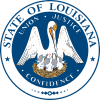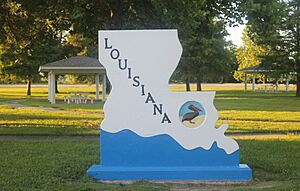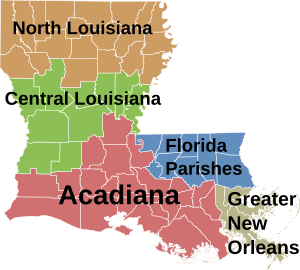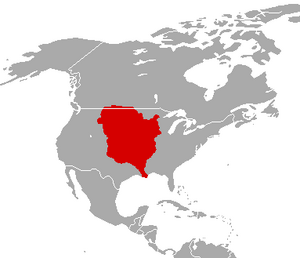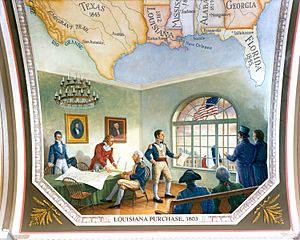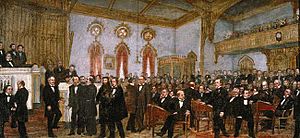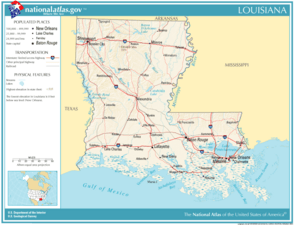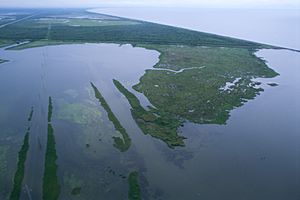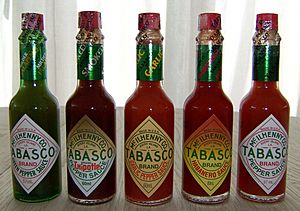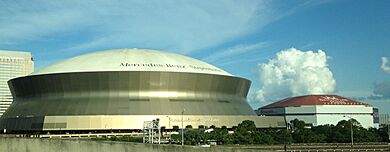Louisiana facts for kids
Quick facts for kids
Louisiana
|
|||
|---|---|---|---|
| State of Louisiana État de Louisiane (French) Estado de Luisiana (Spanish) Létat de Lalwizyàn (Louisiana Creole) |
|||
|
|||
Nickname(s):
|
|||
| Motto(s):
Union, Justice, Confidence
|
|||
Anthem:
|
|||

Location of Louisiana within the United States
|
|||
| Country | United States | ||
| Before statehood | Territory of Orleans and Louisiana Purchase | ||
| Admitted to the Union | April 30, 1812 (18th) | ||
| Capital | Baton Rouge | ||
| Largest city | New Orleans | ||
| Largest county or equivalent | East Baton Rouge Parish | ||
| Largest metro and urban areas | Greater New Orleans | ||
| Legislature | Legislature | ||
| • Upper house | Senate | ||
| • Lower house | House of Representatives | ||
| Judiciary | Louisiana Supreme Court | ||
| U.S. senators | Bill Cassidy (R) John Kennedy (R) |
||
| U.S. House delegation | 4 Republicans 2 Democrats (list) |
||
| Area | |||
| • Total | 52,124 sq mi (135,000 km2) | ||
| • Land | 43,204 sq mi (111,898 km2) | ||
| • Water | 8,920 sq mi (23,102 km2) 15% | ||
| Area rank | 31st | ||
| Dimensions | |||
| • Length | 379 mi (610 km) | ||
| • Width | 130 mi (231 km) | ||
| Elevation | 100 ft (30 m) | ||
| Highest elevation | 535 ft (163 m) | ||
| Lowest elevation | −8 ft (−2.5 m) | ||
| Population
(2024)
|
|||
| • Total | |||
| • Rank | 25th | ||
| • Density | 106.9/sq mi (41.3/km2) | ||
| • Density rank | 26th | ||
| • Median household income | $58,200 (2023) | ||
| • Income rank | 47th | ||
| Demonym(s) | Louisianian Louisianais (Cajun or Creole heritage) Luisiano (Spanish descendants during rule of New Spain) |
||
| Language | |||
| • Official language | None constitutionally specified; Louisiana French (special status under CODOFIL) | ||
| • Spoken language | As of 2010 | ||
| Time zone | UTC−06:00 (CST) | ||
| • Summer (DST) | UTC−05:00 (CDT) | ||
| USPS abbreviation |
LA
|
||
| ISO 3166 code | US-LA | ||
| Traditional abbreviation | La. | ||
| Latitude | 28° 56′ N to 33° 01′ N | ||
| Longitude | 88° 49′ W to 94° 03′ W | ||
| Bird | Brown pelican |
|---|---|
| Fish | Crappie |
| Flower | Magnolia |
| Tree | Bald cypress |
| Insect | Honeybee |
Louisiana (pronounced loo-EE-zee-AN-uh) is a state located in the southern part of the United States. It shares borders with Texas to the west, Arkansas to the north, and Mississippi to the east. Louisiana is the 25th most populated state in the U.S., with about 4.6 million people.
What makes Louisiana special is its strong French heritage. It's the only U.S. state that uses "parishes" instead of "counties" for its local government areas. Baton Rouge is the state's capital, and New Orleans is its largest city. The state also has a long coastline along the Gulf of Mexico, and the mighty Mississippi River forms a large part of its eastern border.
Much of Louisiana's land was created by sediment carried down the Mississippi River. This created huge deltas, marshes, and swamps. These areas are home to many unique animals and plants. You can find birds like ibises and egrets, different kinds of tree frogs (like the state's own American green tree frog), and fish such as sturgeon. Higher areas in the north have different environments, including grasslands and longleaf pine forests. These areas have many plant species, including orchids and carnivorous plants. More than half of Louisiana is covered by forests.
Louisiana's location, where the Mississippi River system meets the Gulf of Mexico, attracted many Native American groups thousands of years ago. Today, Louisiana has eighteen Native American tribes. The French claimed this land in 1682, and it became a major center for their colony of New France. From 1762 to 1801, Spain ruled Louisiana. Then, Napoleon briefly took it back for France before selling it to the U.S. in 1803 as part of the Louisiana Purchase. Louisiana officially became the 18th U.S. state in 1812.
After becoming a state, many new settlers came to Louisiana from other parts of the U.S. and from places like the West Indies, Germany, and Ireland. Farming grew quickly, especially for cotton and sugarcane, which were mostly grown by enslaved people from Africa. Because it was a state that allowed slavery, Louisiana joined the Confederate States of America during the American Civil War.
Louisiana's unique French background is seen in its place names, languages, traditions, and even its laws. Compared to other southern U.S. states, Louisiana is very diverse in its languages and cultures. This mix comes from French (Cajun, Creole), Spanish, Acadian, Native American, and West African cultures. Even though English became the main language in schools for a while, Louisiana has never had an official language, and its constitution protects the right for people to keep their historic languages and cultures alive.
Contents
- The Name of Louisiana
- Louisiana's Past: A Journey Through Time
- Louisiana's Geography and Climate
- Government and Administration
- People and Cultures of Louisiana
- Louisiana's Economy
- Education in Louisiana
- Getting Around Louisiana: Transportation
- Sports in Louisiana
- Famous People from Louisiana
- Images for kids
- See also
The Name of Louisiana
Louisiana was named to honor King Louis XIV of France. He was the King of France from 1643 to 1715.
Louisiana's Past: A Journey Through Time
Early History and Native Americans
Long before Europeans arrived, Native Americans lived in Louisiana for thousands of years. One of the oldest and most complex building sites in North America, Watson Brake, is found in Louisiana. It's a group of 11 mounds built around 3500 BCE. Other ancient sites show that early hunter-gatherers worked together to build large structures.
Many of the names we use today in Louisiana, like Atchafalaya, Natchitoches, Caddo, and Houma, come from Native American languages.
European Explorers Arrive
The first European explorers in Louisiana were Spanish in 1528, led by Pánfilo de Narváez. They found the mouth of the Mississippi River. Later, in 1542, Hernando de Soto's group explored areas north and west of the state.
In 1682, the French explorer Robert Cavelier de La Salle claimed the region for France. He named it Louisiana to honor King Louis XIV. French settlements grew along the Mississippi River, stretching all the way north to the Illinois Country.
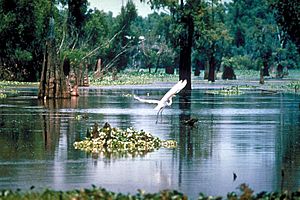
In the 1720s, German families also settled along the Mississippi River in an area called the German Coast. After France lost the Seven Years' War in 1763, it gave up most of its land east of the Mississippi to Great Britain. The rest of Louisiana, including New Orleans, became a Spanish colony in 1762.
In 1800, Napoleon secretly took Louisiana back from Spain.
The Louisiana Purchase (1803)
Napoleon had big plans for Louisiana, hoping to create a new empire. But when his army faced problems, he decided to sell the territory. Thomas Jefferson, the U.S. President, wanted to buy New Orleans and parts of the Mississippi River's east bank to ensure trade.
On April 30, 1803, the U.S. bought the entire Louisiana territory for about $15 million. This purchase, for less than 3 cents an acre, doubled the size of the United States without a war. It opened the way for the U.S. to expand across the continent.
After the purchase, the area was divided into two parts: the Territory of Orleans to the south and the District of Louisiana to the north.
Becoming a State (1812)
Louisiana officially became the 18th U.S. state on April 30, 1812. The Territory of Orleans became the State of Louisiana. Soon after, more land known as the Florida Parishes was added to the state.
By 1840, New Orleans had become one of the wealthiest and largest cities in the nation. It was a major center for the trade of enslaved people. Many enslaved African Americans were forced to move from the Upper South to the Deep South, often sold to traders and transported to New Orleans.
The Civil War and Beyond (1860–1865)
In 1860, nearly half of Louisiana's population was enslaved. Because of this, Louisiana decided to leave the Union in 1861 after Abraham Lincoln was elected president. It joined the Confederate States of America.
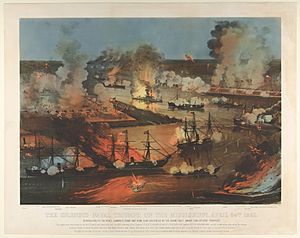
However, the Union quickly captured New Orleans in April 1862. The Union government then allowed parts of Louisiana under its control to act as a state within the Union.
After the Civil War, formerly enslaved African Americans began to gain more rights and opportunities. However, some white groups tried to stop these changes. In the early 1900s, many African Americans left Louisiana in the Great Migration to northern cities, seeking better jobs and education.
World War II brought new jobs to the state. In August 2005, Hurricane Katrina caused huge damage to New Orleans and other low-lying areas, leading to widespread flooding. In August 2016, another storm caused major flooding across southern Louisiana, damaging many homes.
Louisiana's Geography and Climate
Land and Water Features
Louisiana is bordered by Texas, Arkansas, Mississippi, and the Gulf of Mexico. The state has two main types of land: the higher "uplands" in the north and the "alluvial" lands along the coast.
The alluvial region includes low swamps, coastal marshes, and beaches. This area is mostly along the Gulf of Mexico and the Mississippi River. The Mississippi River flows through the state for about 600 miles (1,000 km) and empties into the Gulf. Other important rivers include the Red River and the Ouachita River. Many smaller streams are called "bayous."
The Mississippi River flows along a natural ridge it has built up, called a levee. From this ridge, the land slopes away. The higher lands in the north and northwest cover more than 25,000 square miles (65,000 km2). These areas have prairies and woodlands. The highest point in Louisiana is Driskill Mountain, which is only 535 feet (163 m) above sea level.
Louisiana has many navigable waterways, totaling over 4,000 miles (6,400 km) long. These include the Sabine, Pearl, Calcasieu, and Atchafalaya rivers, among others.
Unfortunately, the southern coast of Louisiana is losing land very quickly. This is largely due to human activities that have stopped the Mississippi River from adding new sediment to the marshes during floods.
Louisiana's Climate
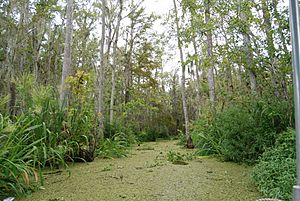
Louisiana has a humid subtropical climate. This means it has long, hot, and humid summers, and short, mild winters. The nearby Gulf of Mexico greatly influences the state's weather.
It rains often throughout the year, with summers being a bit wetter. In summer, temperatures can reach over 95°F (35°C) in the south and even over 105°F (41°C) in northern Louisiana. Winters are generally mild in the south and cool in the north.
Louisiana is often hit by tropical cyclones and is very open to major hurricanes, especially the lowlands around New Orleans. The state's unique geography, with its many bayous and marshes, means that hurricanes can cause widespread water damage. The area also has frequent thunderstorms, especially in the summer. Louisiana averages over 60 thunderstorm days a year, more than almost any other state. The state also experiences about 27 tornadoes each year.
Government and Administration
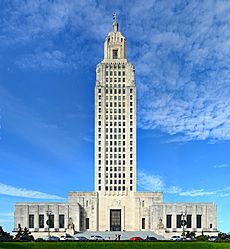
In 1849, the state capital moved from New Orleans to Baton Rouge. The Louisiana State Capitol building and the Louisiana Governor's Mansion are both in Baton Rouge. However, the Louisiana Supreme Court is still located in New Orleans.
Louisiana is divided into 64 "parishes," which are like counties in other states. Most parishes have an elected government called the Police Jury. Its members, called Jurors, are elected by the people and choose a president to lead them. Some parishes have different types of local government.
People and Cultures of Louisiana
Population and Diversity
| Historical population | |||
|---|---|---|---|
| Census | Pop. | %± | |
| 1810 | 76,556 | — | |
| 1820 | 153,407 | 100.4% | |
| 1830 | 215,739 | 40.6% | |
| 1840 | 352,411 | 63.4% | |
| 1850 | 517,762 | 46.9% | |
| 1860 | 708,002 | 36.7% | |
| 1870 | 726,915 | 2.7% | |
| 1880 | 939,946 | 29.3% | |
| 1890 | 1,118,588 | 19.0% | |
| 1900 | 1,381,625 | 23.5% | |
| 1910 | 1,656,388 | 19.9% | |
| 1920 | 1,798,509 | 8.6% | |
| 1930 | 2,101,593 | 16.9% | |
| 1940 | 2,363,516 | 12.5% | |
| 1950 | 2,683,516 | 13.5% | |
| 1960 | 3,257,022 | 21.4% | |
| 1970 | 3,641,306 | 11.8% | |
| 1980 | 4,205,900 | 15.5% | |
| 1990 | 4,219,973 | 0.3% | |
| 2000 | 4,468,976 | 5.9% | |
| 2010 | 4,533,372 | 1.4% | |
| 2020 | 4,657,757 | 2.7% | |
| 2023 (est.) | 4,573,749 | 0.9% | |
| Sources: 1910–2020 | |||
Most of Louisiana's population lives in the southern part of the state, especially around New Orleans and Lafayette. While the state's population grew for a long time, it has recently seen a slight decrease in some areas.
In 2019, about 4.2% of people in Louisiana were immigrants. Most immigrants came from Honduras, Mexico, and Vietnam. New Orleans is known as a "sanctuary city," which means it has policies to protect undocumented immigrants.
Different Cultures in Louisiana
Louisiana is known for its many different cultures. The most famous are the Louisiana Creoles and Cajuns, who are descendants of early French and Spanish settlers.
African Culture
When the French first settled Louisiana, they brought many enslaved people from West Africa. These individuals kept their cultural traditions alive, leading to a unique Afro-Creole culture. Later, many refugees from the Haitian Revolution came to New Orleans, bringing more African cultural influences, especially in dance, music, and religious practices.
Creole Culture
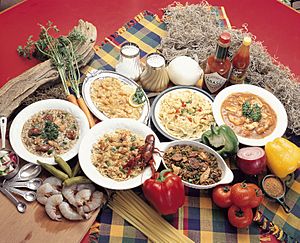
Creole culture is a mix of French, African, Spanish, and Native American traditions. The word "Creole" originally referred to Europeans born in the New World. Over time, it also came to describe a group of mixed-race people, often of African and French descent, who were free even before the Civil War. These "Creoles of Color" often spoke French, were Roman Catholic, and became skilled workers and property owners. They created a vibrant culture, especially in New Orleans.
Acadian (Cajun) Culture
The ancestors of the Cajuns came from a French colony in Canada called Acadia. After the British took over Acadia in 1763, many Acadians were forced to leave. Many of them settled in southern Louisiana, especially around Lafayette. Here, they developed their own unique rural culture, including Cajun music and cuisine.
Isleño Culture
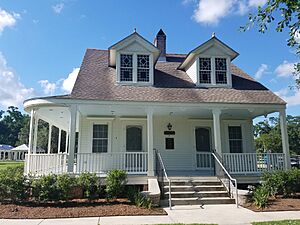
Another distinct culture in Louisiana is that of the Isleños. These are descendants of colonists from the Canary Islands who settled in Spanish Louisiana between 1778 and 1783. They mixed with other groups like the French and Acadians. While some of their communities became more French, the community in Saint Bernard kept much of its unique culture and language for a long time. Today, there are groups that work to preserve the Isleño heritage.
Religion in Louisiana
| Religion in Louisiana (2020) | ||||
|---|---|---|---|---|
| Religion | Percent | |||
| Protestant | 53% | |||
| Catholic | 22% | |||
| Other Christian | 1.5% | |||
| Unaffiliated | 19% | |||
| Jewish | 1% | |||
| Other faith | 4% | |||
Louisiana is one of the most Christian states in the U.S. In 2020, about 76.5% of adults were Christian.
In the northern part of the state, most people belong to various Protestant churches. In southern Louisiana and the New Orleans area, many people are Catholic due to the French and Spanish heritage. This strong Catholic presence makes Louisiana different from many other Southern states.
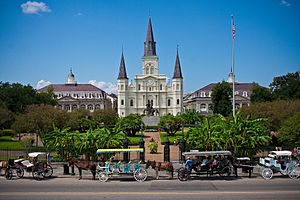
Jewish communities are found in Louisiana's larger cities, especially New Orleans. Other religions like Islam, Buddhism, and Hinduism are also present, mainly in the metropolitan areas.
Louisiana's Economy
Louisiana's economy is growing and becoming more diverse. It benefits from its population, farm products, and lots of oil and natural gas. The state is known for being friendly to small businesses.
Louisiana is the world's biggest producer of crawfish, supplying about 90% of them! Other important farm products include cotton, soybeans, cattle, sugarcane, poultry, and rice. The state also has strong industries in chemical products, petroleum, and paper. Tourism and gaming are also very important, especially in New Orleans.
The Port of South Louisiana, located on the Mississippi River, is one of the busiest shipping ports in the world. It handles a huge amount of cargo.
New Orleans, Shreveport, and Baton Rouge are home to a growing film industry, earning Louisiana the nickname "Hollywood South." This is partly due to state financial support. Tabasco sauce, a famous hot sauce, was created on Avery Island in Louisiana.
In 2020, Louisiana's total economic output was $253.3 billion, which was the 26th highest in the U.S.
Education in Louisiana
Louisiana has over 40 public and private colleges and universities. Some of the major ones include:
- Louisiana State University (LSU) in Baton Rouge, which is the largest university in the state.
- Louisiana Tech University in Ruston.
- University of Louisiana at Lafayette in Lafayette, the second largest by enrollment.
- Tulane University in New Orleans, a major private research university known for its academics.
Louisiana also has two of the oldest and largest historically black colleges and universities (HBCUs): Southern University in Baton Rouge and Grambling State University in Grambling. These two schools have a big football game called the Bayou Classic every year.
In 2008, Louisiana passed a law called the Louisiana Science Education Act. This law allowed public school teachers to use extra materials in science classes that question established science topics like evolution and global warming.
Many parents in Louisiana choose private schools for their children. The state also has a school voucher program, which helps students pay for private school tuition.
Getting Around Louisiana: Transportation
The Louisiana Department of Transportation and Development manages the state's public transportation, roads, bridges, and airports.
Roads
Louisiana has a network of Interstate Highways and U.S. Highways that help people travel across the state.
Interstate Highways |
United States Highways
|
Rail Travel
Six major freight railroads operate in Louisiana. For passengers, Amtrak runs three long-distance train routes through the state, all starting from New Orleans. These trains connect Louisiana to cities like New York, Chicago, and Los Angeles.
Public Transit

The New Orleans Regional Transit Authority is the largest public transportation agency in Louisiana. Other cities like Baton Rouge, Lafayette, and Shreveport also have their own transit systems.
Airports
Louis Armstrong New Orleans International Airport (MSY) is the busiest airport in Louisiana. There are also six other main airports in the state, including those in Baton Rouge, Shreveport, and Lafayette. In total, Louisiana has 69 public-use airports.
Waterways
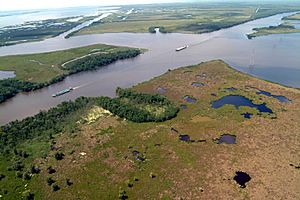
The Gulf Intracoastal Waterway is very important for moving goods like petroleum, farm products, and building materials.
Sports in Louisiana
Louisiana is unique because it's the least populated state with more than one major professional sports team. These include the National Basketball Association's New Orleans Pelicans and the National Football League's New Orleans Saints.
The state also has 12 college NCAA Division I sports programs. The LSU Tigers football team has won many championships. New Orleans hosts several big college football games each year, like the Bayou Classic and the New Orleans Bowl. The city has also hosted the Super Bowl a record eleven times!
Louisiana is known for producing many talented athletes. For several years, it has been the birthplace of the most NFL players per person in the country.
Famous People from Louisiana
- Phil Anselmo, singer
- Terry Bradshaw, former NFL quarterback
- James Carville, political strategist
- Patricia Clarkson, actress
- Ellen DeGeneres, comedian and TV host
- Armand Duplantis, pole vaulter
- Mannie Fresh; DJ and producer
- Kevin Gates; rapper and singer
- DJ Khaled; DJ and record executive
- Angela Kinsey, actress
- Ali Landry, actress and Miss USA 1996
- Jared Leto, actor and musician
- Jerry Lee Lewis; singer and piano-player
- Huey Long, politician
- Peyton Manning, former American football quarterback
- Tim McGraw, singer and actor
- Tyler Perry, actor, director, and producer
- Dustin Poirier; mixed martial artist
- Zachary Richard; Cajun singer and poet
- Ian Somerhalder, actor
- Britney Spears; singer and dancer
- Jamie Lynn Spears, singer and actress
- Lil Wayne; rapper and singer
- Shane West, actor and singer
- Reese Witherspoon, actress
- YoungBoy Never Broke Again; rapper and singer
Images for kids
-
A field of yellow wildflowers in Saint Bernard Parish, Louisiana
See also
 In Spanish: Luisiana para niños
In Spanish: Luisiana para niños



